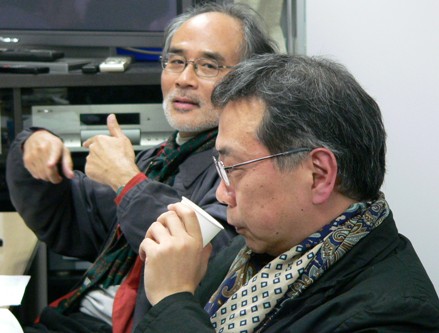Report: UTCP Work Salon "The Prehistory of Knowledge/The Archival Study of Knowledge: What is 'the Age of Criticism?'"
Hidetaka Ishida was a guest of this week's work salon to discuss the significance of the manuscript of The Archeology of Knowledge.
The publication of Michel Foucault’s Dits et Ecrits and Cours au College de France was an event that changed the reading of his preceding works. The access to his manuscripts also continues to expand their possibilities. L”Archeologie du Savoir (1969) has a so-called original manuscript, which is worth the attention as offering the possibility to put in relief an aspect of Foucault’s discourse theory that has been not noticed. Professor Ishida not only focused on the meaning of this pre-original, but by linking its theoretical kernel to his own research project, he also demonstrated the wide scope this manuscript can cover. The differences between the published L’Archeologie du Savoir and the pre-original manuscript are extremely big. Professor Ishida, who has read the manuscript, pointed out that this text, written around 1966 – identifying the time of writing has a great significance, taking into consideration the dense intellectual climate of the period - , was much more voluminous than L’Archeologie du Savoir. A striking difference with the published version is the lack of reference to Chomsky and Anglo-Saxon analytic philosophy.
However, what attracted most the attention was the presence of the theory of “enunciated-thing” (enonce-chose) as a pair to the theory of “enunciated-event” (enonce-evenement), which is central to the discourse theory of L’Archeologie du Savoir. This theory, that was not reflected in the published version can have the significance of a groundwork of a media-theory, as it is a theory of the material means=media, that realize the enunciation.
One should also note than the pre-original outs into question the contemporaneous discursivity of the 20th century. According to Foucault our age is characterized with a system of a discourse of saying everything, that is, as an “age of generalized discursivity”, where a “universal archive” has began to form itself. Foucault’s notion of archive is defined not only by the aspect of the event, but also by the aspect of the “thing”, and in the present state of total archivization it is rather the theory of “enunciated-thing”, than that of “enunciated-event”, in other words, the material and technical aspects of Foucault’s discourse theory, that come to light. The main emphasis of this talk was on the significance as a media-theory of this theory of “enunciated-thing”.
Why is it that in the end this theory of “enunciated-thing” had to recede? Hidetaka Ishida’s hypothesis is that Foucault oriented himself towards the interior theoretical construction in order to distinguish his own discourse theory from the Theory of Propositions of Chomsky’s linguistics and logic, as well as from the Anglo-Saxon analytical philosophy.
The scope of this theory of “enunciated-thing”, interpreted as basic theory of media-theory is very wide. It is so, because it relates to the exteriority, excluded in the purification of the discourse theory, that is, to the materiality and sociality of communication. Consequently, this theory opens up even the possibility for treating the spheres outside of discourse or preceding discourse. For example, the possibility of an archeology of gestures, so-to-say, a paleontology of knowledge, that Foucault did not address. The notion of gestures could also be linked to the theory of discipline, following L’Archeologie du Savoir. This theory also offers the possibility of analyzing the “Enlightenment” as an age of criticism with relationship to the script. According to Professor Ishida, Foucault has avoided the relationship between the script and enlightenment. The relationship between the reading public and the force of knowledge should rather be analyzed by linking the”enunciated-thing” to the technical media.
The width of scope of the pre-original was suggested at the end of the talk, but in the discussion the question whether the “enunciated-thing” was removed from the published version. To the question of Yasuo Kobayashi whether the theory of “enunciated-thing” has reached a different conclusion in the subsequent writings, a junior scholar of Foucault, Takashi Abe suggested that the idea of “genealogy” is latently based on it (to which Hidetaka Ishida agreed). The relationship with the ensuing development of the theory of authority, the connection with the debate with Derrida and many other questions were raised, but unfortunately, we did not have enough time to discuss them in detail.
As reference material the following articles were handed out during the talk.
・ 「フーコー、もうひとつのディスクール理論」、『シリーズ言語態1 言語態の問い』、東京大学出版会 2001、pp. 311-342.
・「メディア分析とディスクール理論」、『シリーズ言語態5 社会の言語態』、東京大学出版会 2002、pp. 283-317.
(Dan Morita, English translation: Dennitza Gabrakova)







